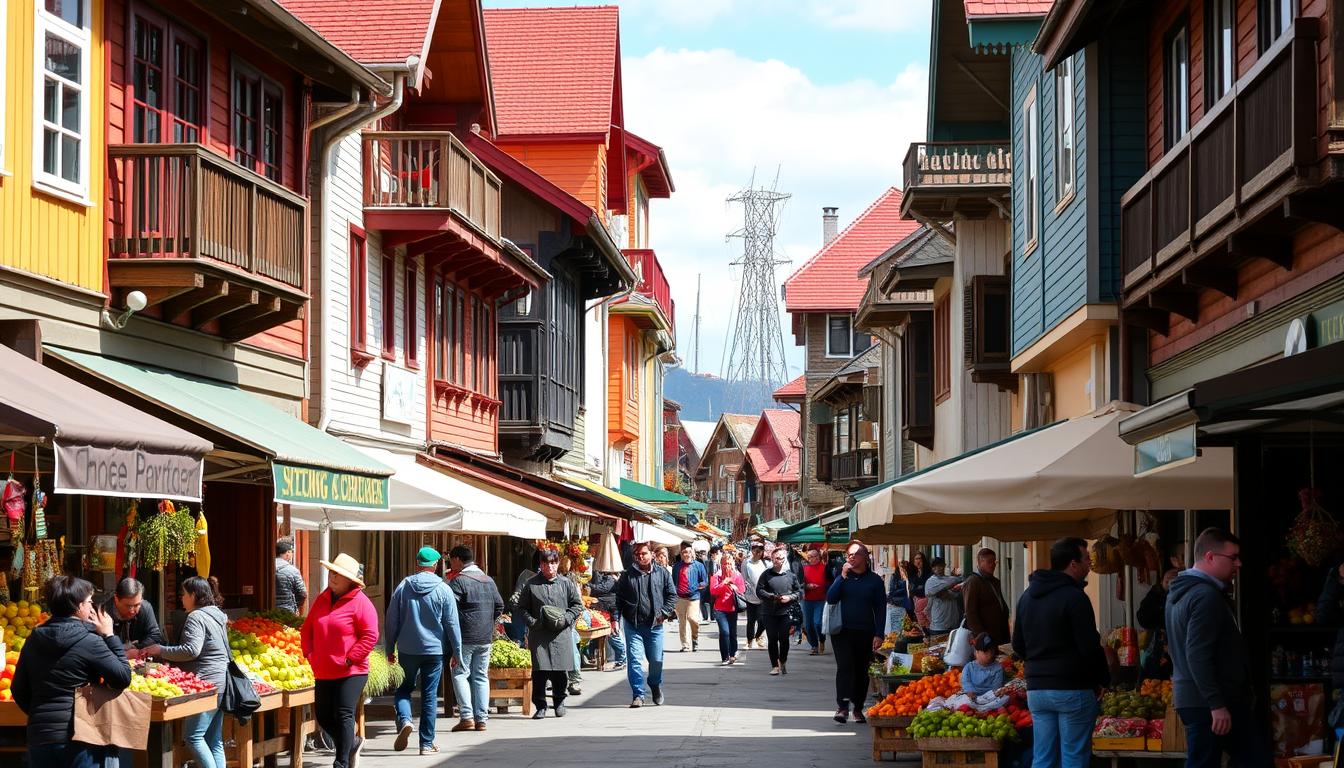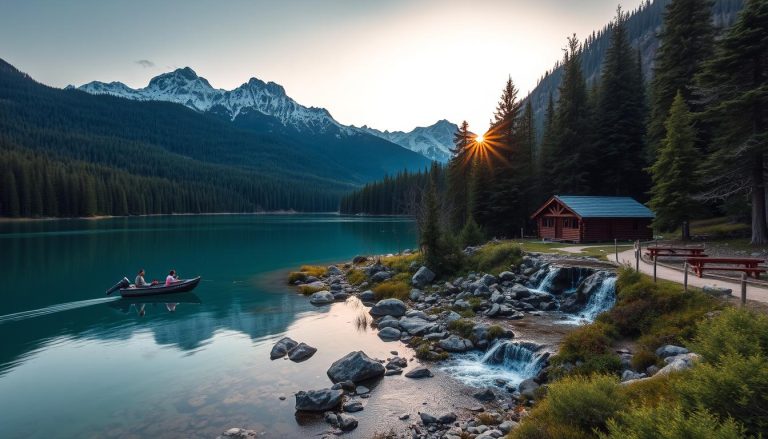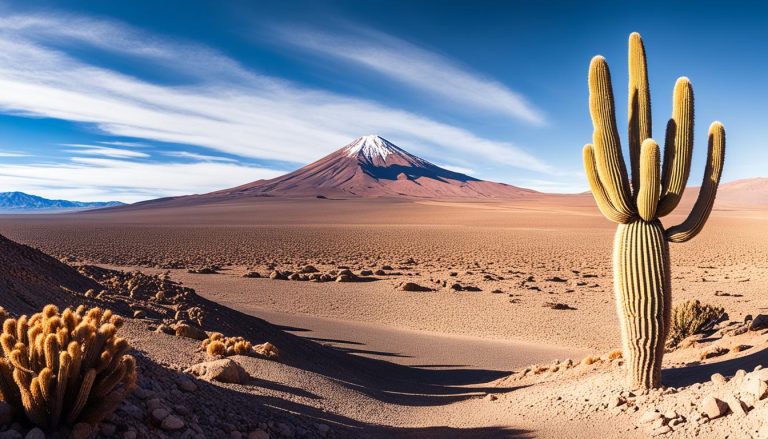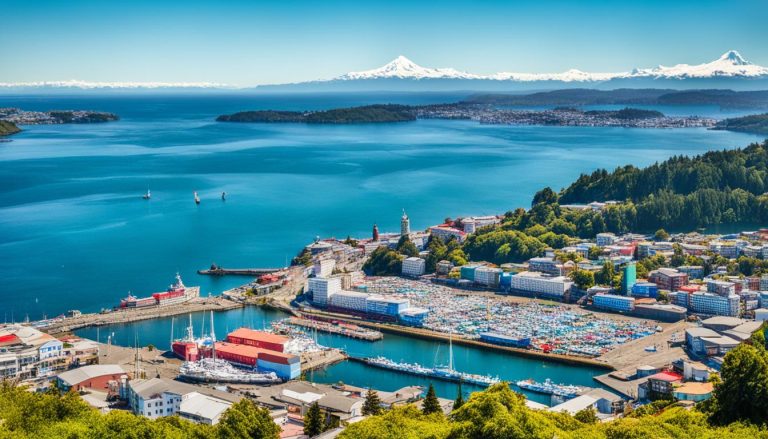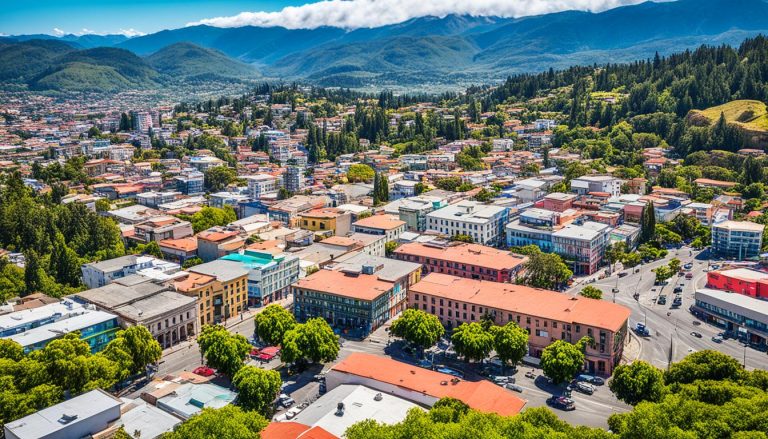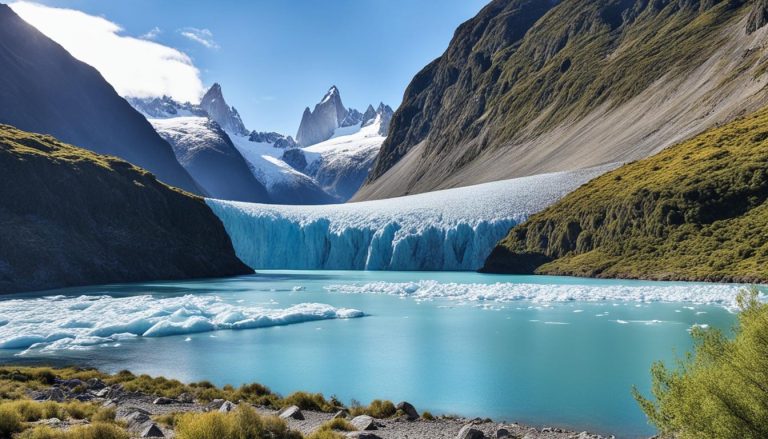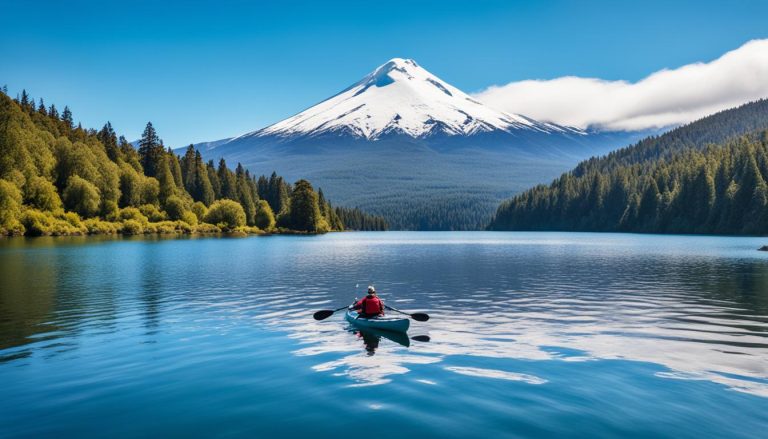Ever wondered about the hidden gems on Chiloé Island in Northern Patagonia? Get ready for a trip to Castro, a city where old meets new. Here, colonial vibes mix with indigenous culture for a unique adventure.
Castro is a place of beauty, from its famous stilt houses to its delicious Chilote food. It’s perfect for those who love nature, history, or meeting locals. So, what makes Castro a must-see destination?
Key Takeaways
- Discover the unique blend of colonial and indigenous influences in Castro, the capital of Chiloé Island
- Explore the iconic palafitos (stilt houses) that have become a symbol of the city’s coastal charm
- Indulge in the renowned Chilote cuisine, showcasing the region’s abundance of seafood and local specialties
- Uncover the rich cultural heritage and UNESCO-recognized wooden churches scattered across the archipelago
- Immerse yourself in the natural wonders of Chiloé National Park and the private Tantauco Preserve
Introduction to Castro, Chiloé Island
Chiloé Island is a hidden gem in Northern Patagonia, full of magic and mystery. It’s part of a 41-island group, far from the mainland. This place has a unique culture, shaped by both colonial and indigenous roots. You’ll find a strong Catholic faith, traditional ways of farming and fishing, and beautiful crafts and wooden buildings.
Overview of Chiloé Island and its unique charm
Chiloé Island has its own special culture, shaped over the years. It’s famous for over 100 wooden churches, with 16 recognized by UNESCO. These churches show off a long tradition of carpentry that started in the 17th century.
Highlights of Castro, the capital city
Castro, the capital of Chiloé Island, is full of sights and experiences. You can see the famous palafitos, or stilt houses, by the water. The San Francisco Church is another must-see, with its bright colors.
Don’t miss trying the local food, like curanto, and visiting the Mercado Municipal. It’s a great way to taste Chilote cuisine.
“Chiloé Island is a world apart, isolated not only by distance from the mainland but also by the quirks of history.”
Exploring the Iconic Palafitos of Castro
In Castro, the capital of Chiloé Island, you’ll find a unique sight. The palafitos are wooden houses on stilts by the water. They show the island’s rich culture and the cleverness of its people.
What are Palafitos and Their Cultural Significance
The palafitos look like traditional boats, showing Chiloé’s fishing and maritime past. Fishermen and carpenters built them as a smart way to live by the coast. Now, they stand as symbols of the island’s mix of colonial and indigenous cultures.
The palafitos are more than just pretty to look at. They mean a lot to the people of Chiloé Island. They represent the island’s strength, flexibility, and the tight community life here for many years.
Best Spots to Admire and Photograph the Palafitos
For the best views of Castro’s palafitos, go to the Mirador Gamboa or the Indura Market. At Mirador Gamboa, you’ll see the palafitos and their reflections in the water at low tide or during sunset.
At the Indura Market, you can see the colorful palafitos along the coast. Walking through this market lets you enjoy the palafitos and dive into Chiloé Island’s culture and traditions.
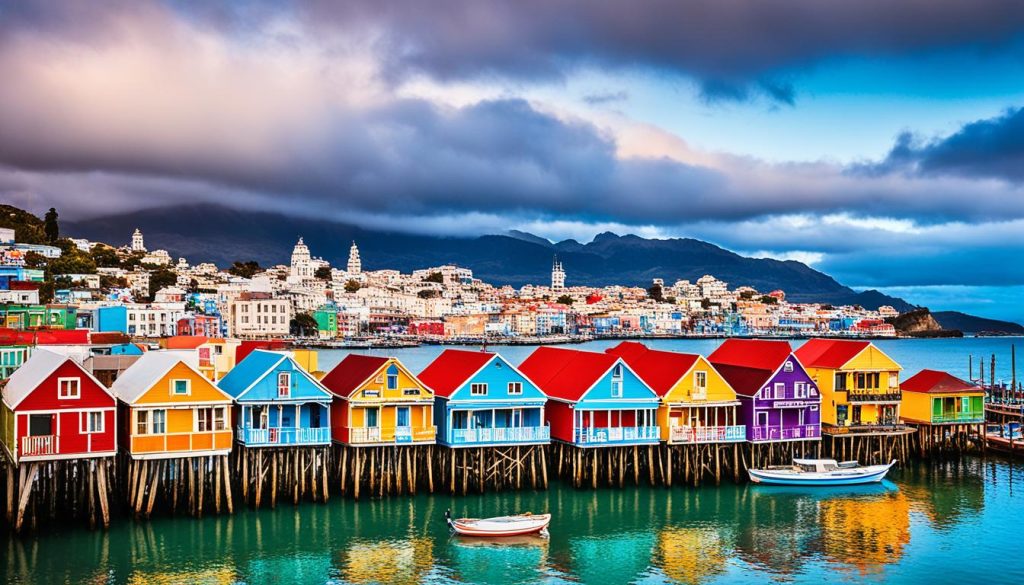
If you love photography or admire architectural beauty, don’t miss the palafitos of Castro. They’re a key spot that will make your visit to Chiloé Island unforgettable.
Visiting the San Francisco Church
In the heart of Castro, Chiloé Island, the San Francisco Church is a key spot. It’s known for its bright yellow and purple outside. This makes it a standout in the city.
The church was built to bring the local people to Catholicism. The current building was finished in 1912 after fires destroyed earlier ones. You can go inside for free and see it lit up at night for a stunning view.
This church is important for its culture and history. It shows the rich past and unique design of Chiloé Island. It’s one of the many Chiloé Island churches that highlight the island’s Chiloé Island architecture and traditions.
“The San Francisco Church is a true gem of Castro, capturing the essence of Chiloé’s extraordinary cultural legacy.”
Seeing the church’s outside during the day or its lights at night is a must. It’s a key stop for anyone visiting Castro and Chiloé Island.
Indulging in Chilote Cuisine
Visiting Castro, the capital of Chiloé Island, is a treat for food lovers. This city is famous for its fresh seafood, tasty shellfish, and traditional Chilote dishes. You’ll find everything from the flavorful curanto to the beloved empanadas and Chilean cakes.
Traditional Dishes to Try in Castro
The curanto is a must-try dish in Castro. It’s a mix of seafood, meat, potatoes, and veggies cooked in a pit. This method gives the food a rich, earthy taste. Another favorite is the empanada, a pastry filled with various fillings like seafood, meat, or cheese.
Popular Restaurants and Markets for Local Food
For delicious Chilote dishes, visit the Mercado Municipal. Here, you can find fresh ceviche and a wide range of produce, fish, and cheese. Near Rio Chacra, you’ll see cafes and restaurants on stilts, offering a unique dining spot. Don’t miss the empanada truck near the bus station for a quick, tasty snack.
Walking along Castro’s main road, you’ll find shops, butchers, and bakeries. They sell local ingredients and homemade treats. This is a great way to experience the local food scene.
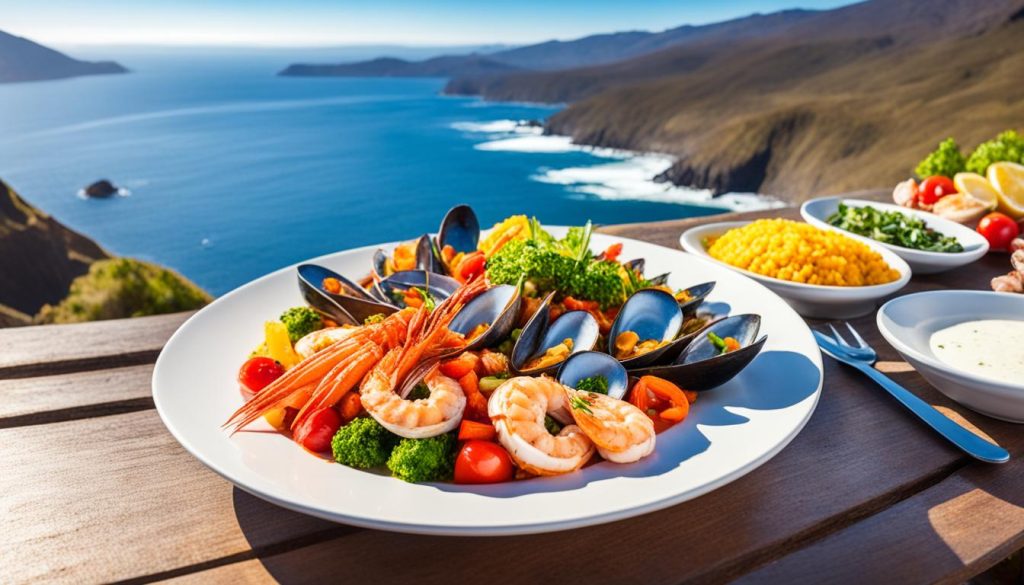
“Indulging in the rich and flavorful Chilote cuisine is an essential part of experiencing the cultural heritage of Chiloé Island.”
Castro has a lot to offer for food lovers. Whether you want fresh seafood, traditional Chilean dishes, or local market finds, you’ll find it all. The Chilote flavors will leave you wanting more.
Day Trips from Castro
Castro is more than just a city on Chiloé Island. It’s a gateway to exciting day trips. Just 30 minutes away is Dalcahue, known for its bustling market and fresh seafood. For a quieter trip, take a ferry to Quinchao Island. There, you’ll find UNESCO World Heritage wooden churches and a peek into traditional life.
Exploring the Wooden Churches of Chiloé
Quinchao Island is famous for its UNESCO Wooden Churches of Chiloé. These churches were made by local fishermen and carpenters. They show off the island’s long tradition of carpentry since the 17th century.
The Church of Santa María de Loreto de Achao is a standout. Its roof curves like traditional boats, mixing colonial and indigenous styles. This reflects the island’s unique culture.
| Destination | Distance from Castro | Key Highlights |
|---|---|---|
| Dalcahue | 30 minutes | Artisanal market, seafood |
| Quinchao Island | Short ferry ride | UNESCO Wooden Churches, traditional towns |
Visiting nearby towns and islands from Castro lets you dive into Chiloé Island’s culture and beauty. You can see UNESCO wooden churches or explore local markets. These trips from Castro will definitely make an impact.
Castro, Chile: Best Things to Do - Top Picks
Castro on Chiloé Island, Chile, is a city full of charm. It has attractions and experiences that will capture your heart. You can see the famous palafitos (stilt houses) or try the local food. Castro mixes culture and nature in a special way.
Don’t miss the San Francisco Church in Castro. It’s known for its bright colors. This church from the 18th century shows the island’s rich history and faith.
For a taste of Chilote’s food, check out the local markets and eateries. Try the curanto and fresh seafood. You’ll also feel the island’s warm welcome.
Castro is a great spot for exploring nearby places. Visit towns like Dalcahue and Quinchao Island. See the UNESCO-listed wooden churches that show the area’s cultural treasures.
If you love adventure, the Chiloé National Park is perfect. It has trails for hiking. You can see rivers, lakes, and wildlife up close.
Castro and its area have something for everyone. Whether you want culture, food, or nature, you’ll find it here. Discover the top things to do in Castro, the best attractions in Castro, and dive into the Castro Chile tourism experience.
| Top Attractions in Castro, Chile | Description |
|---|---|
| Palafitos (Stilt Houses) | Iconic wooden houses built on stilts along the waterfront, showcasing the island’s unique architectural heritage. |
| San Francisco Church | A historic 18th-century church known for its vibrant yellow and purple exterior, reflecting the island’s cultural identity. |
| Chilote Cuisine | Indulge in the region’s traditional dishes, such as curanto, featuring fresh seafood, meats, and local produce. |
| Nearby Day Trips | Explore the surrounding towns and islands, including Dalcahue and Quinchao, to visit UNESCO-listed wooden churches. |
| Chiloé National Park | Hike through the diverse landscapes of rivers, lakes, and wildlife while immersing in the island’s natural beauty. |
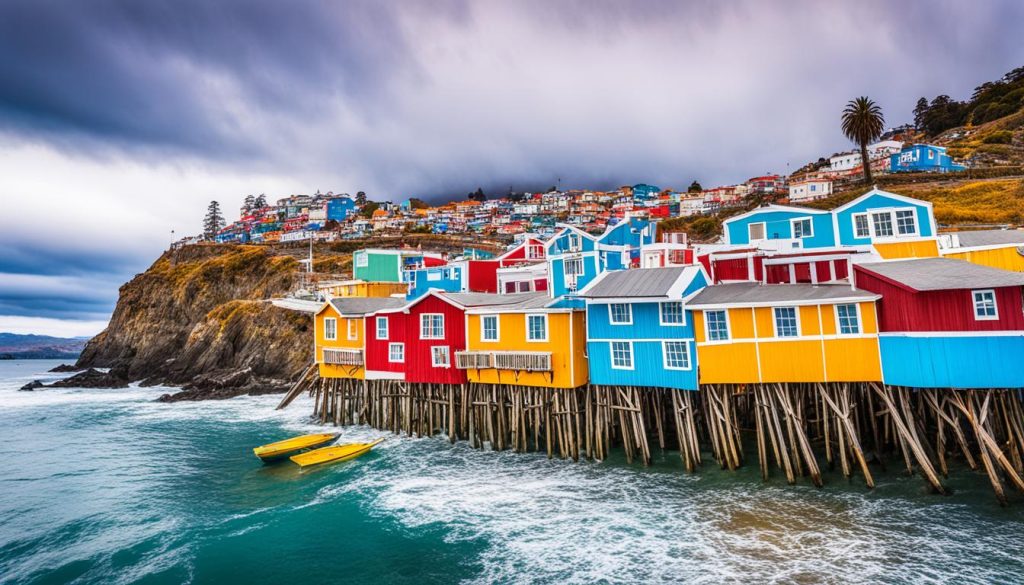
“Chiloé Island is home to over 150 churches built by Jesuit missionaries in the 1500s, out of which around sixty churches remain in a distinctive wood construction style, sixteen of which are UNESCO World Heritage Sites.”
Outdoor Activities around Castro
The town of Castro, on Chiloé Island, is a paradise for outdoor lovers. It’s surrounded by stunning nature. A must-visit spot is the Chiloé National Park. This park covers over 43,000 hectares along the western coast of the island.
Hiking in Chiloé National Park
The park has many hiking trails, like the Sendero El Tepual and Sendero Dunas de Cucao. These trails let you explore lush rainforests and beautiful beaches. The 20-kilometer backpacker’s trek is a bit long, but the park’s beauty and camping spots make it a favorite among nature lovers.
Kayaking and Beach Adventures
Castro and Chiloé also offer great water activities. You can rent kayaks to see the island’s coast, including the mysterious Chepu area and its sunken forest. The beaches in the national park are peaceful, perfect for spotting locals digging for razor clams at low tide.
For a deeper outdoor adventure, Tantauco Park is a private area with 100,000 hectares of wild nature. It has hiking, fishing, and more exciting activities.
Chiloé Island and Castro offer many ways to enjoy the outdoors. You can hike in the lush national park, kayak along the coast, or find hidden spots. This place will capture your heart with its unique beauty and charm.
Shopping for Handicrafts and Souvenirs
Castro is a great place for travelers to find unique Chiloé Island handicrafts and Chiloé Island souvenirs. It’s famous for its skilled woodworkers. You can check out the Castro markets and shops for wooden items like furniture and decorations.
The Mercado Municipal and other markets in Castro and nearby towns are perfect for finding handmade items. You can look for textiles, pottery, and traditional Chilote crafts. This lets visitors bring back a piece of the island’s rich culture.
Local Markets and Artisan Shops
- The Feria Artesanal in Castro is open daily from 9 to dusk. Saturday mornings are the best time to go.
- The crafts market in Dalcahue is by the waterfront municipal building. It’s open every day, with Sunday mornings being the best time.
- Feria Artesanal Llauquil in Quellón has great deals on woolens and straw figures. Prices are already reasonable, so no need to bargain.
- Ancud has an artisans’ market under the town plaza, a few blocks from the waterfront. You’ll find woolen blankets, sweaters, dolls, and wooden figures.
By visiting these markets and shops, you can dive into the Chiloé Island culture. You’ll find a meaningful souvenir to take home.
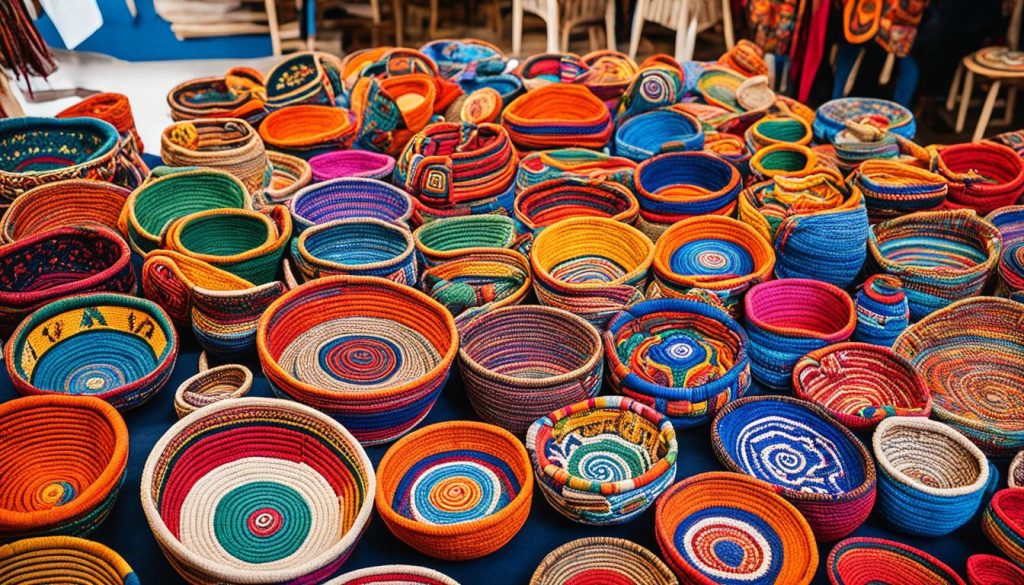
Where to Stay in Castro
When you visit Castro, Chile, and the beautiful Chiloé Island, you’ll find many places to stay. You can choose from budget-friendly hostels to luxurious eco-lodges. Castro has something for every budget and taste.
Top Hotels and Hostels in Castro
For a central and affordable place, think about Hostal Backpacker Chiloe Sur. It’s a cozy hostel close to the Plaza de Armas. Or, experience something unique by staying in a traditional palafito at Palafito Hostel or Palafito Azul. These offer amazing harbor views.
If you want a more upscale stay, check out the Palafito EcoLodge or the Tierra Chiloé Hotel & Spa. The Tierra Chiloé Hotel & Spa is a top-rated hotel. It’s part of the Tierra Hotels group and was named one of the Best Resorts in South America by Condé Nast Traveller Readers’ Choice Awards 2021.
| Hotel | Type | Highlights |
|---|---|---|
| Hostal Backpacker Chiloe Sur | Hostel | Central location, affordable rates |
| Palafito Hostel | Palafito (Stilt House) | Unique accommodation, stunning harbor views |
| Palafito EcoLodge | Hotel | Luxury amenities, eco-friendly design |
| Tierra Chiloé Hotel & Spa | Hotel | Award-winning, part of Tierra Hotels group |
No matter your budget or what you’re looking for, Castro has many Hotels in Castro Chile and Chiloé Island accommodations. You’ll find great places to stay for a memorable visit.
Getting to Castro
Getting to Castro and Chiloé Island is easy with many transport options. The island links to the mainland by bus and ferry. The ferry ride from Pargua to Chacao is about 30 to 40 minutes.
You can also fly into the Castro Airport, opened in 2013. Once there, cars, buses, or bicycles make it easy to see the sights. It’s smart to plan your trip ahead, especially when many people visit, to make your trip smooth.
Transportation Options and Tips
- Ferry service: The ferry crossing from Pargua to Chacao takes 30 to 40 minutes, connecting Chiloé Island to the mainland.
- Bus service: Companies like Cruz del Sur, TransChiloé, and Queilén Bus offer regular buses to Ancud and Castro from places like Puerto Montt and Santiago.
- Air travel: Castro Airport, opened in 2013, is a quick way to get to the island.
- Rental cars: You can rent cars in Castro to see the island at your pace.
- Bicycles: Biking is a great way to get around the island’s towns and beautiful routes.
Remember to check schedules and book tickets early, especially in busy seasons. This will help make your trip to Chiloé Island and Castro smooth and fun.
Conclusion
Castro and Chiloé Island offer a unique travel experience in Chile. You’ll find vibrant palafitos, historic churches, and a rich culinary scene. There are also outdoor adventures to enjoy.
Chiloé Island’s capital, Castro, is a great place to start exploring. It’s known for its mix of colonial and indigenous culture. You can see iconic palafitos by the water and UNESCO-listed wooden churches.
Whether you’re making a Chiloé Island travel guide or just visiting Castro, Chile, you’ll have a great time. This place will leave a lasting impression on your Chilean trip. Enjoy the warm Chilote culture and let Castro charm you.
